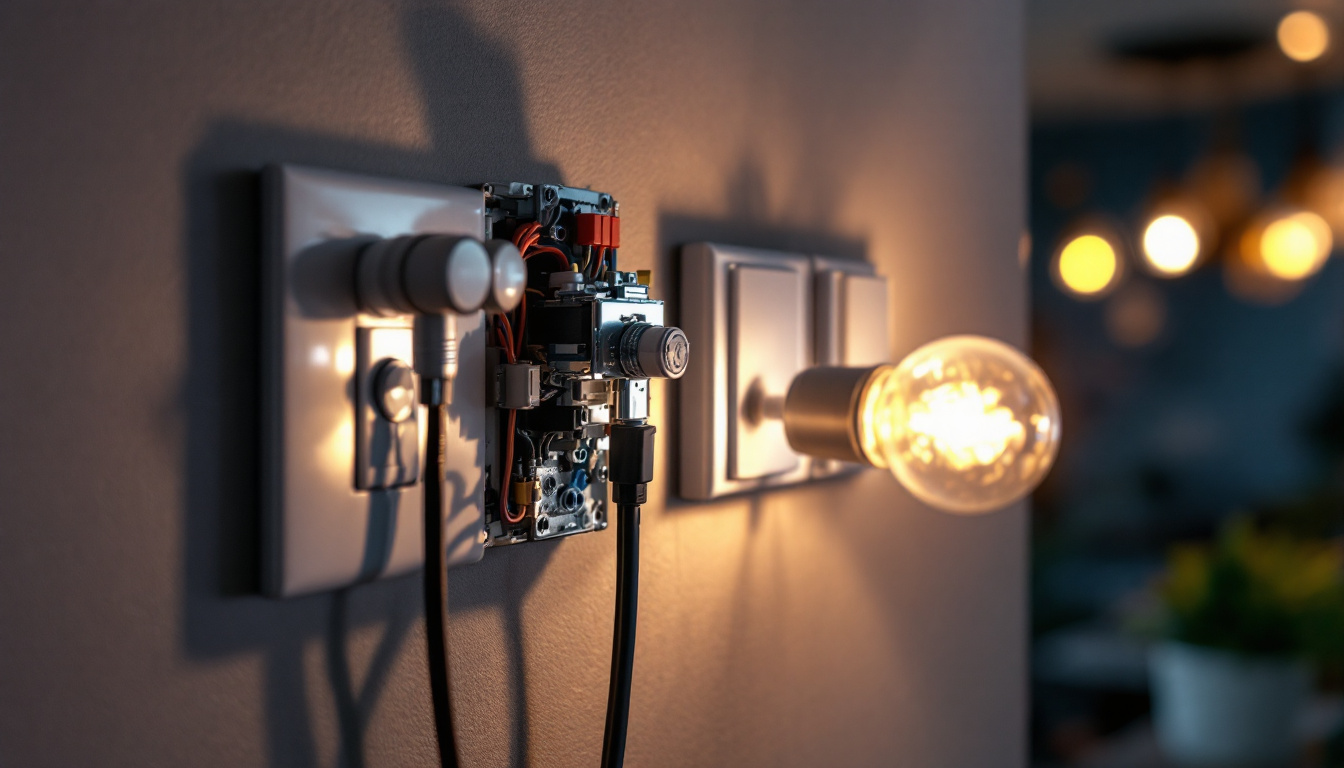
The threeway light switch is an essential component in modern electrical systems, allowing for the control of lighting from two different locations. This feature is particularly useful in larger spaces such as hallways, staircases, or expansive rooms where a single switch would be impractical. For lighting contractors, understanding the functionality and installation of threeway switches is crucial for delivering effective solutions to clients.
At its core, a threeway switch operates through a unique wiring system that differs from standard single-pole switches. Instead of a direct connection to the light fixture, threeway switches utilize a pair of switches that communicate with each other, enabling the user to control the same light from multiple points. This complexity can pose challenges during installation but also offers opportunities for contractors to showcase their expertise.
A typical threeway switch system consists of two switches and a light fixture. The wiring includes three main types of wires: the common wire, which connects to the light fixture; and two traveler wires, which link the two switches. Understanding these components is vital for lighting contractors to ensure proper installation and functionality.
In addition to the basic components, contractors must also be aware of the various types of threeway switches available on the market, including mechanical and smart switches. Each type has its own installation requirements and benefits, which can influence project decisions. For instance, smart threeway switches can be integrated into home automation systems, allowing users to control their lighting via smartphone apps or voice commands. This modern twist not only enhances user convenience but also attracts tech-savvy clients looking to upgrade their living spaces with cutting-edge technology.
Incorporating threeway light switches into lighting projects offers several advantages. Firstly, they enhance convenience, allowing users to control lighting from multiple locations, which is particularly beneficial in homes and commercial spaces. This feature is increasingly demanded by clients looking to improve the functionality of their environments.
Moreover, threeway switches can contribute to energy efficiency. By providing better control over lighting, they enable users to turn off lights in areas that are not in use, reducing unnecessary energy consumption. This aspect not only appeals to environmentally conscious clients but also aligns with the growing trend of sustainable building practices. Additionally, the strategic placement of threeway switches can enhance safety in homes, particularly in staircases and hallways, where adequate lighting is essential to prevent accidents. By ensuring that lights can be easily turned on or off from both ends of a staircase, homeowners can significantly reduce the risk of falls, making their living spaces safer and more accessible for all family members.
While threeway switches offer numerous benefits, their installation can present challenges for lighting contractors. Understanding these challenges is essential for ensuring a smooth installation process and satisfying client expectations.
The wiring involved in a threeway switch system can be more complex than that of a standard switch. Contractors must be adept at identifying the correct wires and ensuring they are connected properly to avoid issues such as flickering lights or complete failure of the lighting system. Miswiring can lead to costly rework and client dissatisfaction.
Additionally, contractors should be familiar with local electrical codes and regulations that govern the installation of threeway switches. Compliance with these codes is essential not only for safety but also for maintaining the integrity of the project. Knowledge of these regulations can also help contractors avoid legal issues and potential fines, making it a critical aspect of the installation process.
Another challenge that contractors may face is the physical space available for installation. In some cases, existing structures may not provide adequate room for the necessary wiring or the switches themselves. This can require creative solutions, such as using low-profile switches or rerouting wiring to accommodate the design.
Accessibility is also a concern, especially in commercial settings where multiple users may need to operate the lighting. Ensuring that switches are placed at appropriate heights and locations is crucial for usability and compliance with accessibility standards. Moreover, contractors must consider the potential for future renovations or changes in layout that could impact the functionality of the installed switches. Planning for flexibility in design can save time and resources in the long run, allowing for easier adjustments as the needs of the space evolve.
Furthermore, contractors should also take into account the aesthetic aspects of switch placement. Clients often have specific preferences regarding the look and feel of their spaces, and switches should blend seamlessly with the overall design. This may involve selecting finishes that match existing decor or considering the visual impact of switch placement in relation to furniture and fixtures. Balancing functionality with aesthetics can be a delicate task, but it is essential for achieving a satisfactory result that meets both practical and stylistic expectations.
The rise of smart home technology has introduced a new dimension to threeway switches. Smart threeway switches allow for remote control of lighting through mobile applications or voice commands, providing an added layer of convenience and sophistication to lighting projects.
Smart threeway switches offer several advantages over traditional switches. They can be programmed to work on schedules, allowing users to automate their lighting based on their daily routines. This feature not only enhances convenience but can also lead to significant energy savings.
Furthermore, these smart devices often integrate with other home automation systems, allowing for seamless control of lighting alongside other smart devices. For lighting contractors, this opens up new avenues for upselling and providing comprehensive solutions that meet the evolving needs of clients.
While smart threeway switches provide numerous benefits, their installation requires a different approach compared to traditional switches. Contractors must ensure that the existing wiring can support the smart technology and may need to educate clients on the setup process and compatibility with their home networks.
Additionally, understanding the specific features and requirements of various smart switch brands is essential for successful installation. This knowledge enables contractors to recommend the best products for their clients’ needs while ensuring a smooth installation process.
When planning lighting layouts, the inclusion of threeway switches can significantly influence the overall design and functionality of a space. Lighting contractors must consider how the placement of these switches will affect the user experience and the aesthetics of the environment.
The strategic placement of threeway switches is crucial for maximizing their effectiveness. Contractors should evaluate the flow of the space and determine the most logical locations for switch placement. For instance, in a long hallway, placing switches at both ends can enhance accessibility and convenience.
In residential settings, contractors may also consider the lifestyle of the occupants. Families with children may benefit from switches placed at lower heights, while older adults may require switches that are easier to reach. Understanding the needs of the client can lead to more tailored and satisfactory lighting solutions.
Threeway switches also play a vital role in creating ambiance within a space. By allowing for multiple control points, contractors can design lighting layouts that enable users to adjust the lighting intensity based on the activity or mood. This flexibility is particularly valuable in spaces such as dining rooms, where lighting can significantly impact the dining experience.
In commercial settings, adjustable lighting can enhance the overall atmosphere, making it more welcoming for customers. Contractors should collaborate with clients to understand their vision and incorporate threeway switches into designs that facilitate this adaptability.
The landscape of lighting technology is continually evolving, and threeway switches are no exception. Staying abreast of emerging trends is essential for lighting contractors looking to remain competitive in the industry.
The integration of threeway switches with Internet of Things (IoT) technology and artificial intelligence (AI) is on the rise. This trend allows for even greater control and automation of lighting systems. For instance, AI can learn user habits and adjust lighting accordingly, further enhancing energy efficiency and user convenience.
Contractors who embrace these technologies can offer cutting-edge solutions that appeal to tech-savvy clients. Understanding the capabilities and installation requirements of IoT-enabled devices will be crucial for successful implementation.
As sustainability becomes a priority for many consumers, the demand for energy-efficient lighting solutions continues to grow. Threeway switches, particularly smart models, can contribute to energy savings by allowing users to better manage their lighting usage.
Contractors should be prepared to discuss energy-efficient options with clients and highlight the long-term cost savings associated with these solutions. This approach not only benefits clients but also positions contractors as knowledgeable professionals committed to sustainable practices.
The threeway light switch is more than just a functional component of lighting systems; it represents an opportunity for lighting contractors to enhance the user experience and offer innovative solutions. Understanding the intricacies of threeway switches, from installation challenges to emerging technologies, is essential for delivering successful projects that meet client needs.
As the industry continues to evolve, contractors who stay informed about trends and advancements in lighting technology will be better equipped to provide exceptional service. By embracing the potential of threeway switches, lighting contractors can create spaces that are not only functional but also aesthetically pleasing and energy-efficient.
Ready to elevate your lighting projects with the innovative threeway switches and the latest in lighting technology? Look no further than LumenWholesale for all your lighting needs. Our extensive selection of spec-grade lighting products is designed to meet the highest industry standards, ensuring you deliver reliable and high-performance lighting solutions to your clients. With unbeatable wholesale prices and the convenience of free shipping on bulk orders, you can trust LumenWholesale to provide premium lighting at the best value. Don’t let middleman markups dim your project’s potential. Discover wholesale lighting at the best value today and brighten your professional offerings with LumenWholesale.

Discover how modern exterior house lights are revolutionizing efficiency for lighting contractors.

Discover the essential best practices lighting contractors use when integrating LED mirrors into modern spaces.

Discover the frequent pitfalls lighting contractors face with Bulb T8 installations.

Discover the transformative impact of LED cabinet lighting and why staying updated is crucial for lighting contractors.